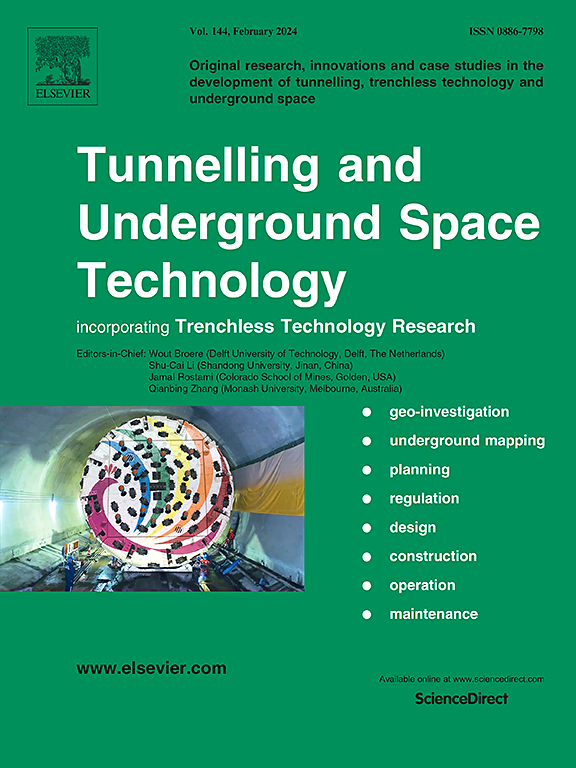The role of wall slip and temperature in shield tail seal performance: A novel modeling approach
IF 6.7
1区 工程技术
Q1 CONSTRUCTION & BUILDING TECHNOLOGY
引用次数: 0
Abstract
The increasing number of tunnel construction projects utilizing shield machines has led to frequent occurrences of tail seal failure. Current models for predicting shield tail sealing performance often neglect crucial factors such as wall slip and temperature-dependent grease properties, leading to inaccurate predictions and suboptimal designs. This study presents a novel computational model that incorporates both wall slip and temperature effects to accurately predict the performance of seals. The model utilizes a finite element method approach with a non-Newtonian fluid model to capture the complex rheological behavior of the sealing material. The simulation results reveal that neglecting wall slip can lead to an underestimation of grease leakage amount and the water pressure resistance of the tail seal system, highlighting the critical importance of incorporating this effect in seal design. When the wall slip effect is considered, the breaking water pressure of the tail seal brush is 0.45 MPa, while the breaking water pressure is only 0.34 MPa when the wall is considered to be non-slip. Furthermore, it was demonstrated that temperature variations significantly influence the pressure distribution within the seal. When the temperature is 10 °C, the breakdown water pressure is 0.88 MPa, while when the temperature rises to 60 °C, the breakdown water pressure is only 0.07 MPa. This study provides a significant advancement in seal design by offering a more accurate and comprehensive model that incorporates both wall slip and temperature-dependent material properties. The model can facilitate the design of more reliable and efficient shield tail sealing systems.
壁面滑移和温度对盾构尾密封性能的影响:一种新的建模方法
随着盾构机在隧道施工中的应用日益增多,盾构机尾封失效事故频繁发生。目前用于预测屏蔽尾密封性能的模型往往忽略了关键因素,如壁滑移和与温度相关的润滑脂特性,从而导致预测不准确和设计不理想。本研究提出了一种新的计算模型,该模型结合了壁面滑移和温度的影响,可以准确地预测密封的性能。该模型采用非牛顿流体模型的有限元方法来捕捉密封材料的复杂流变行为。仿真结果表明,忽略壁面滑移会导致对油脂泄漏量和尾密封系统水压阻力的低估,突出了在密封设计中考虑这一影响的重要性。考虑壁面滑移效应时,尾封刷的破水压力为0.45 MPa,考虑壁面防滑时,破水压力仅为0.34 MPa。此外,还证明了温度变化对密封内部压力分布有显著影响。当温度为10℃时,击穿水压为0.88 MPa,而当温度升至60℃时,击穿水压仅为0.07 MPa。该研究提供了一个更准确、更全面的模型,结合了壁滑移和温度相关的材料特性,为密封设计提供了重大进步。该模型可为设计更可靠、更高效的屏蔽尾密封系统提供参考。
本文章由计算机程序翻译,如有差异,请以英文原文为准。
求助全文
约1分钟内获得全文
求助全文
来源期刊

Tunnelling and Underground Space Technology
工程技术-工程:土木
CiteScore
11.90
自引率
18.80%
发文量
454
审稿时长
10.8 months
期刊介绍:
Tunnelling and Underground Space Technology is an international journal which publishes authoritative articles encompassing the development of innovative uses of underground space and the results of high quality research into improved, more cost-effective techniques for the planning, geo-investigation, design, construction, operation and maintenance of underground and earth-sheltered structures. The journal provides an effective vehicle for the improved worldwide exchange of information on developments in underground technology - and the experience gained from its use - and is strongly committed to publishing papers on the interdisciplinary aspects of creating, planning, and regulating underground space.
 求助内容:
求助内容: 应助结果提醒方式:
应助结果提醒方式:


